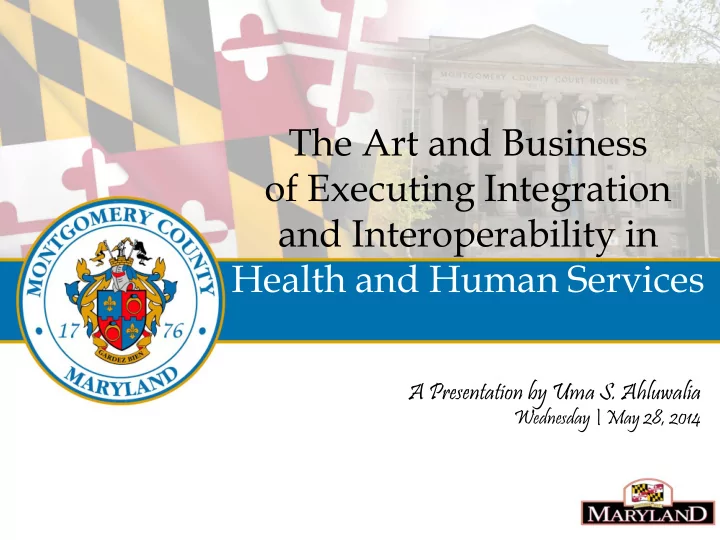

The Art and Business of Executing Integration and Interoperability in Health and Human Services A Presentation by Uma S. Ahluwalia Wednesday | May 28, 2014
Information About our County. Almost 1 Million Residents 50.6% Racial/Ethnic 17% Growth in our senior __________ Minority population over the next 2-years 32% Foreign Born (2010 Census) (2010 Census) Served 120,000 49,344 out of 148,779 6 Zip Codes of Extreme Households in Fiscal Year children in the public Need — Poverty on the 2012. One-third used school system receives Rise more than two services FARMS from Department Caseloads Growing Serving almost 34,000 TCA: 43.4% A Staff of 1,600 with over uninsured adults, children 80 Programs SNAP: 166% and pregnant women MA: 68.7% 2 2 2
How is the Department Organized? One Director Centralized Administrative Functions Designated entire HHS Moving towards Uniform intake entity as HIPAA single client record covered – including form to identify support by an social service and interoperable all service needs income support database programs 3
Building an Integrated Service Delivery System. Defining the Middle • 20% of Clients • No Wrong Door • What Does Using 80% of Integration Mean • 100% Intake Resources for the 80% of Clients who uses 20% of Resources? Intensive Case Front Door Teaming 4
Building an Integrated Service Delivery System. Practice Policy People Infrastructure • Integrated • Confidentiality • Training • Technology Intake • Ethics • Tools • Quality Service • Assessment Review (QSR) • Dispute • Accountability • Case Planning Resolution • Caseload Sizes • System • Service • Equity Evaluation • Contract Delivery Monitoring • Others • Analytics 5
An Aspect of Interoperability. Technology Modernization Integrated Case Practices Integrated Business Process Enterprise-wide Client View Improved Outcomes Analytics and Individual Client Focus and Population Health Focus 6
The Process and Technology Modernization (PTM) Program lays the foundation for changing DHHS service delivery over the next few years. Drivers Goals Changes in service delivery Improve client outcomes Reduce overall costs of best practice Changes required by the treatment Establish single platform for Affordable Care Act (ACA) most service delivery implementation Prepare for ACA-mandated Difficulty/cost in maintaining changes many one-off applications Simplify on-going application supporting programs maintenance Inefficiencies from using Realize vision of integrated DHHS multiple state systems 7
Service Delivery Tomorrow. … to a more integrated service delivery model that treats clients holistically and cost-effectively. o No Wrong Door for Treatment residents needing services Assessment o Consolidated view Eligibility of client engagement across Intake most programs Aging and Behavioral Children Public Special o Integrated service Disability Health Youth and Health Needs delivery where Families Housing appropriate Client 8
The PTM Program includes 7 Interrelated Projects. 9 IT Implementations 1. Enterprise Integrated Case Management (EICM) 2. Enterprise Content Management System (ECMS) 3. Electronic Health Record (EHR) Supporting Projects 4. U. S. Health and Human Services Interoperability Grant 5. Organizational Change Management (OCM) 6. Project Management Office (PMO) 7. Quality Assurance (QA)
Another Aspect of Interoperability. 10 Sharing of Information Policy and Practice Business Process Need to Know Role Based Access Balance between Interoperability/Data- sharing and Guarding against Breaches
Why Integrate Data? Over 30% of our clients use multiple services Clients often have to tell their story multiple times and data has to be entered multiple times. Increases the risk of errors in the re-telling and re-entering Without a master client index, it is hard to tell what services a client is getting across our enterprise and often services are duplicated and there is waste and inefficiency Makes re-use of data impossible and it makes it more difficult for clients to access multiple services across the enterprise 11
Lessons Learned • Public Sector Contracting is painful and time consuming – use EHR transaction example • Change Management is deep and difficult work especially when there are four generations of employees in the workplace – Boomers, Xers, Yers and Millenials • Communicate, Communicate, Communicate • Importance of strategic alignment • Resilience to build as we fly
Uma S. Ahluwalia, Director Department of Health and Human Services | Rockville, Maryland 20850 240.777.1266 13
Recommend
More recommend